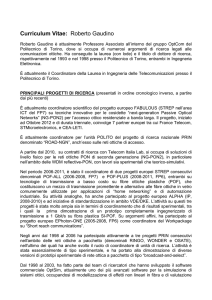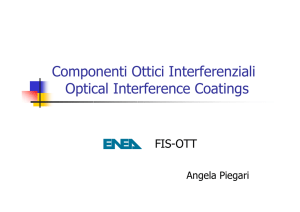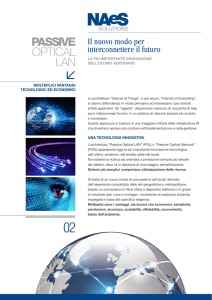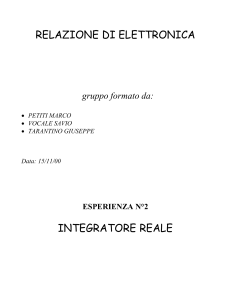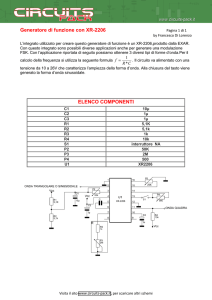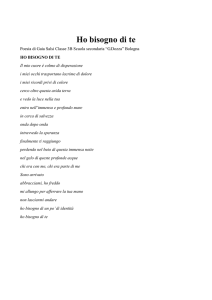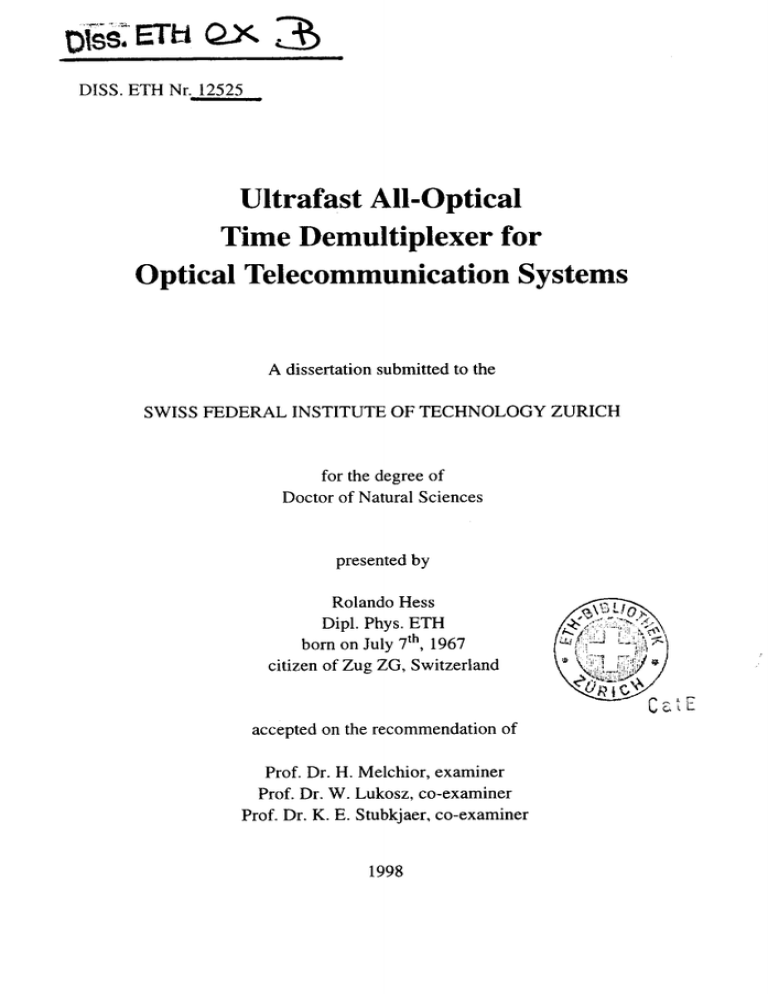
Dfes: ETH
ax
rg>
DISS. ETH Nr. 12525
Ultrafast
Time
All-Optical
Demultiplexer for
Optical Telecommunication Systems
A dissertation submitted to the
SWISS FEDERAL INSTITUTE OF TECHNOLOGY ZURICH
for the
degree
of
Doctor of Natural Sciences
presented by
Rolando Hess
Dipl. Phys.
born
citizen of
accepted
on
ETH
July 7th, 1967
Zug ZG, Switzerland
on
the recommendation of
Prof. Dr. H. Melchior, examiner
Prof. Dr. W. Lukosz, co-examiner
Prof. Dr. K. E.
Stubkjaer,
1998
co-examiner
Abstract
The
enormous intrinsic
fibers
optical
bandwidth and the
together
with
relatively
services
is
offering an interesting challenge
technology High-capacity optical networks are key elements for
communication
applications
in
bioadband
by
of the demand for broadband
steady growth
a
low attenuation offered
like
communication
to
lightwave
the emerging
high-definition
internet,
conferencing, parallel supercomputing, local
To
aiea networking, metropolitan area networking and wide area networking
exploit at best the multi-gigabit capacity offered by the optical fiber medium,
high-definition
television,
bottlenecks
generated by
video
the
optical
electronic
to
electronic
or
avoided, implementing transparent all-optical networks,
remain in
to
optical
within the network's nodes and at the node's interfaces should be
conversion
the
optical
format until
they
arrive
at
in
which the
signals
their destinations
To take full
advantage of the bandwidth offered by optical fiber communication,
wavelength division multiplexing (WDM) and optical time division multiplexing
schemes
(OTDM)
being
are
number of
likely
to
be
realized
The
first
while the latter relies
takes
advantage
on
time
perform routing as well as add/drop functions tor
packets, ultra-fast demultiplexers to demultiplex the time multiplexed
optical
switches able to
of
streams
adaptation
short
and
pulses
wavelength
converters
In this thesis
we
focus
our
(MZI-SOA's) which
and
multiplexers
attention
can
control
converters
as
the
pulse
The
devices
non-linear elements
of these MZI-SOA's relies
in
optical amplifiers
optical amplifiers
sequences, which
modify
the
1
their
are
with
(NLE's)
realized
in
monolithically
The operation
induced refractive index
optically
through properly synchronized optical
on
NLE's
in
switches, demultiplexers, add/drop
planar waveguide technology
integrated optical amplifiers
changes
data
perform wavelength
all-optical monolithically integrated
on
act as space
wavelength
passive-active InP/InGaAsP
principle
to
data
network interfaces
at
Mach-Zehnder interferometers with semiconductor
arms
of
multiplexing of a
lower-bit rates, single-wavelength channels Both approaches are
part of future all-optical networks and need key components such as
multi-wavelength operation,
phase
conditions
in
the interferometer,
switching
causing
A
transfer function and
been
proposed
experimental
and
simple
a
pulse
qualitative
theoretical model which
uses
a
response behaviour to describe the MZI-SOA has
and its theoretical
predictions
found to be
agreement with
in
data
The MZI-SOA comprises multi-mode interference
couplers
both for
signal
and control
truly optically
couplers (MMI) as 3-dB
pulse coupling This feature allows to use the
controlled space switches
devices
as
gigabits
has been demonstrated with first devices
Packet
switching
at a tew
second technological implementation, MZI-SOA's with improved
a
performances have been obtained These devices, together with a differential
optical control scheme, allowed us to demonstrate error-free all optical
demultiplexing of 80 Gbit/s OTDM data streams into 10 Gbit/s data sequences
(world-breaking record for monolithically integrated interferometnc waveguide
With
switches,
to
date) and penalty-free 40
10 Gbit/s
to
demonstrated the simultaneous add and
demultiplexing Moreover,
drop capability
we
of the MZI-SOA's tor
40 Gbit/s OTDM data streams
A novel method to
(RZ) signals, which
optical
conversion
wavelength
over
in
uses
conversion
the differential control scheme to
of
such
a
30
nm
conversion
wide
four-wave
the limited
proposed
With
penalty-free 40 Gbit/s all-optical wavelength
To our best knowledge, no other method can provide
of RZ-signals with a good efficiency at such bit rates,
demonstrated
we
over
return-to-/ero
overcome
modulation bandwidth intrinsic of the SOA's, has been
method
this
perform all-optical wavelength
wavelength
mixing
continuous FWM
range MZI-SOA
(FWM)
can
also be used to suppress pump
Preliminary results
operation and for
pulsed
are
presented
both
for
regimes
discuss the technological implementation of the MZI-SOA's, the
patterned substrates for large bandgap shifts and the chip-to-chip and
fiber-to-chip coupling and packaging technique
We also
growth
briefly
on
2
Riassunto
L'enorme
fibre
di banda
larghezza
ottiche,
assieme
e
la relativamente bassa attenuazione offerta dalle
alia domanda continuamente crescente per
comunicazione a
larga banda,
condutton ottici
Le reti ottiche ad alta capacita
per
apphcazioni nguardanti
offrono
una
sfida interessante alia
larga
servizi a
sono 1
banda
reti
locah,
metropohtane
reti
e
regionah Per
reti
capacita dell'ordine dei Terabits offerta dal
utihzzare elementi di
interfacce delle reti ottiche Un
ottiche
dove
trasparenti,
elettro-ottici
conversione
ll
possibile
segnale
e
internet, televisione ad
supercalcolaton paralleh,
sfruttare
mezzo
di
dei
costituenti fondamentah
come
alta nsoluzione, video conterenze ad alta nsoluzione,
servizi
1
tecnologia
in
ottico
modo ottimale la
si
deve evitare di
opto-elettronici
nodi
nei
alle
e
approccio consiste nell'utilizzo di reti
forma
in
nmane
dal
ottica
punto di
trasmissione fino alia destinazione
Per sfruttare pienamente la banda ottica
attuah fanno
d'onda
lunghezze
lunghezza
d'onda
(WDM) oppure sulla multiplazione temporale di una sola
(OTDM) II pnmo metodo permette di aumentare la capacita
aumentando ll
trasmessa
lunghezza
d'onda ed
capacita
Reti
e
numero
di
ottiche
ultra
temporalmente
rapidi
in
o
utilizzeranno
fondamentah
estrarre
di canah
gh
entrambi
come interruttori
a
una
sola
piu bassa
approcci
e
ottici capaci di
pacchetti di dati (funzionahta add/drop),
di estrarre dati
precedentemente multiplati
lunghezza d'onda
utih alle interfacce tra reti
grado
convertiton di
e
ll secondo utihzza
muhplazione temporale
avanzate
deviare oppure di aggiungere
demultiplaton
lunghezze d'onda,
basato sulla
quindi componenti
necessiteranno
disponible, 1 sistemi di comunicazione
multiplazione spettrale di diverse
di approcci basati sulla
uso
ottiche diverse
In
questa
tesi di
dottorato
amphficaton ottici
Questo
componente
con
a
ci
puo
demultiplatore/multiplatore
L' MZI-SOA
InP/InGaAsP
e
con
stato
occupiamo di
un
interferometro di Mach-Zehnder
semiconduttore integrati monoliticamente
e
e
di
(MZI-SOA)
ottico,
lunghezza
come
d'onda
tecnologia planare attivo-passiva
con
ottici
interruttore
convertitore
come
reahzzato
amphficaton
II pnncipio di funzionamento
come
operare
integrati
come
elementi
non
hnean
in
(NLE)
basato sul cambiamento dell'indice di nfrazione
3
ottico indotto tramite sequenze sincronizzate di
del
fase
nell'interferometro
segnale
componente abbiamo proposto
una
funzione di trasfenmento
accordo
sono in
L'MZI-SOA
operano
dei
a
3-dB
di
dati alia velocita di alcuni
ottici
usare
all'MZI-SOA
nsultati
spenmentah
ci
avendo
spaziah,
(MMI)
permette di
a
che
usare
1
disposizione
complementan dell'interferometro Abbiamo
gh MZI-SOA come interruttori per pacchetti di
gigabits
mighon Questi componenti,
differenziale,
1
del
quahtativa
associa
carattenstica
tecnologica ha permesso di
La seconda iterazione
ottico
Questa
interruttori
ven
possibihta
carattenstiche
che
nsposta ad impulso,
e una
simultaneamente le due uscite
dimostrato la
semphce
dei divison di fascio passivi multimodah
accoppiaton
come
ottici che modificano la
descnzione
le simulazioni
comprende
come
componenti
con
modello
un
impulsi
la
Per
ottenere
assieme
ha permesso di dimostrare la
80 Gbit/s
ad
uno
degh MZI-SOA
con
schema di controllo
demultiplazione
senza erron
segnali da 10 Gbit/s (attualmente record
mondiale, usando interferometri a guida d'onda integrati) e la demultiplazione di
sequenze a 40 Gbit/s senza penalita Inoltre abbiamo dimostrato che e possibile
di
segnah OTDM
a
utihzzare l'MZI-SOA
Presentiamo anche
segnali
come
elemento di
metodo
un
di tipo ntorno
m
a zero
nuovo
(RZ)
add/drop
per convertire la
40 Gbit/s
a
per dati OTDM
schema di controllo ottico differenziale
su uno
a
lunghezza
spettro di 30
40 Gbit/s
d'onda per
nm, usando lo
Questo schema permette di
evitare l
problemi connessi alia limitata larghezza di banda nella modulazione ottica degh
amphficaton ottici a semiconduttore I nsultati ottenuti sono senza penalita su
tutta la banda ottica misurata
sono
altn metodi di
(30 nm)
conversione
RZ Gh MZI-SOA possono anche
negh espenmenti
di miscelazione
essere
a
per ll modo di operazione continuo
Descnviamo brevemente
MZI-SOA,
discutiamo
parzialmente
i
la
ci
a
queste velocita per
utihzzati per filtrare ll
quattro onde Riportiamo
e
per
tecnologia
quello
segnale
l
non ci
segnali
di pompa
nsultati ottenuti
modulato
utihzzata per la fabbncazione
nsultati della tecnica di crescita
mascherato per ottenere
differenti, infine
A nostra conoscenza, attualmente
altrettanto efficienti
guide
ottiche
con
epitassiale con
degh
substrata
hvelh di energia
proibita
soffermiamo sulla tecnica di montaggio per moduli che
permette di accoppiare componenti
con
fibre ottiche
4
guide
d'onda diversi tra di loro
o con


